Highlights on Ozone and UV activities 2017-2022
Short summary of different activities in support of ozone and UV observations, their quality assurance and quality control, and capacity building since 10th Ozone Research Managers meeting.
Reports and activitiesUpdated Guidelines for Global Ozonesonde Operations
Ozone sounding records constitute the longest time series of the vertical ozone distribution and constitute a key component for monitoring changes in stratospheric ozone in accordance with the Montreal Protocol. Over the last 20 years, ozonesondes have become increasingly important in understanding tropospheric ozone pollution.
The electrochemical-concentration cell (ECC) ozonesonde has been used at ~100 stations worldwide starting 50 years ago. Each ozonesonde instrument is launched and lost so it is prepared and given a preliminary calibration before its ascent. This introduces a level of imprecision in station time-series. There are two types of ECC ozonesonde used in the sonde network and these have undergone hardware changes over the decades. Thus, ozone records from a given station may show biases depending on which instrument is used and how it is prepared before flight. Details of the chemical sensing solution used in the cells and data processing also affect the ozonesonde measurement. Thus, there are a number of causes of random and systematic uncertainties in ozonesonde records. Since 2004, the WMO - GAW-sponsored ASOPOS (Assessment of Standard Operating Procedures of OzoneSondes) team of experts has been evaluating ozone records and the results of field and laboratory experiments that intercompare ozonesondes to a reference standard. A first Guidebook on “best practices” was published in 2014: WMO/GAW Report 201. Since 2018, thanks to a new Juelich Ozonesonde Intercomparison Experiment (2017) and at the urging of the ozone trends community, the ASOPOS team has been working on a new set of recommendations. It describes how, with more standardization of SOP’s on (i) preparation before launch and (ii) post flight data processing, it is possible to achieve the 5% uncertainty level in tropospheric and stratospheric ozone requested by the satellite and trends communities.
Completed ASOPOS (Assessment of Standard Operating Procedures (SOPs) for Ozone Sondes) 2.0 Report: Updated Guidelines for Global Ozonesonde Operations are published as WMO - GAW Report 268.
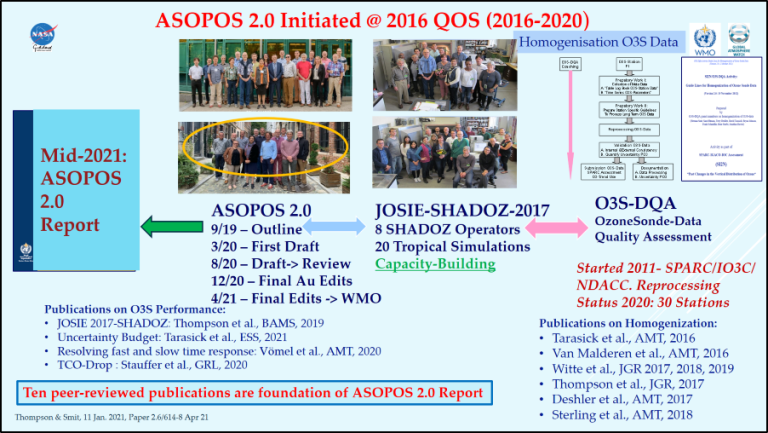
2021 planned activities of the World Dobson Calibration Center
Glen McConville from the World Dobson Calibration Center will be traveling to Mauna Loa Observatory on Big Island, Hawaii to calibrate the World Dobson standard 083 in 2021. The Langley observations will take place from July 12 to the end of August. The Lapenta program intern, Leah Barkai, will be supporting this project and help to operate Dobson 083 and the station instrument at MLO. After the end of the calibration period, the new ET calibration constant will be derived for use by the WMO GAW Dobson network. This-year trip is rescheduled from the last year when travel to Mauna Loa Observatory was not allowed due to COVID-10 restrictions.
In addition to the activity above, Glen McCnville, with support from Steve Rhodes and Matt Tulley of the Bureau of Meteorology, Australia are in the process of transporting the non-functioning Dobson instrument from Perth Australia to Boulder, CO, USA for refurbishing and an upgrade to the WinDobson automation system. The rebuild of the observing system is scheduled for 2021-2022, with subsequent installation of the Dobson at Perth in 2022. The restart of the Dobson operations in Perth will resume the long-term total ozone and Umkehr record in Australia. The very few ozone profiling systems are available in the Southern Hemisphere and therefore the restart of the Perth record will support satellite validation and assessment of the stratospheric ozone recovery.
NOAA’s Global monitoring laboratory has made Dobson observations at Amundsen-Scott Base in Antarctica since 1963. Because the sun is below the horizon for six months of the year, the operators use a special technique called reflected moon focused image (RMFI). Tim Holland, and Joseph Samaniego received training and practiced making RMFI measurements at Boulder, Colorado before deployment to Antarctic.
2020-2022 activities of WMO Regional Dobson Calibration Center for Europe, Hohenpeissenberg (MOHp), Germany
The center is working with colleagues from WMO and Belarus on development and implementation of plan to relocate Dobson instrument to Belarus to serve as reference for total ozone column (TOC) observations of Belarusian ozone observing network. The project will include development of method to trace observations made by Belarussian observing method to the global TOC observations made by Dobson instruments. The project start date is tentatively set for July 2022.
A join WMO/GAW-NDACC Meeting on Outstanding Issues of QA/QC of Total Ozone Column was held online on 16 November 2021. 27 experts participated in the meeting. Discussions included topics related to GAW-QA/QC Documents & Tools for Total Ozone Measurements and namely what exists, what is missing, do existing documents need an update and how we can fill in the gaps in Data Quality Objectives, Standard Operating Procedures, Data Quality Indicators, Overal Uncertainty, Traceability, Meta Data.
In November 2021 Ozone community wished "Happy Retirement" to their respected colleagues, dear friends and strong leaders in global ozone column observations by Dobson instruments: Mr. Ulf Köhler and Mr. Gerrie Coetzee. At the same time Dr. Velazco Voltaire was welcomed as replacement of Mr. Köhler and the new scientific head of RDCC-Europe.
Dobson Ad-Hoc Committe meeting was held online on 10 November 2021. 21 experts participated in this event. Status and past activities of the calibration centers as well as their plans were presented. An Introduction of new O3 X-sections and application of Teff etc. (effective Mue, measured slit functions..) in the data processing in close cooperation between Karl/Voltaire (MOHp), Irina/Glen (IO3C and NOAA Boulder) and Alberto (Izana) was given by Ulf Köhler. Discussions confirmed the support for the continuation of the DAHC to serve as advisory board. The importance to work closely with SAG for O3 and UV and ET-ACMQ was emphasized. NDACC Dobson and Brewer working group, as well as EUBREWNET group are other groups with significant overlap with the DAHC. It is in the best interest of the community that work should be synchronized across all groups to eliminate duplications and misalignment. DAHC new Chair TBD. DAHC-webpage was created and will continue to be maintained by Martin Stanek. Thank you Martin!
In 2021 the activities of the WMO Regional Dobson Calibration Center for Europe at the Meteorological Observatory Hohenpeissenberg (MOHp) in Germany have been strongly affected by the restrictions imposed due to COVID-19 pandemic situation. For example, planned Dobson calibration services for instruments from Poland, Iceland, Shetlands, Ukraine and France in 2020, had to be changed drastically. The travel of participants in the calibration campaigns from different countries in Germany was not possible, thus some of the calibration services were postponed to 2021. Only unaccompanied instruments from Iceland (D050), India (D036) and the Shetlands (D041) were received by MOHp in 2020. In addition to those two Dobsons, the refurbished instrument D036 from New Delhi (India) was operated by the staff of Hohenpeissenberg and also by a student, as the PI from India was not allowed to travel to Germany. Moreover the spare Dobson D092 (formerly from Greenland) received its final calibration and is now available and ready for relocation.
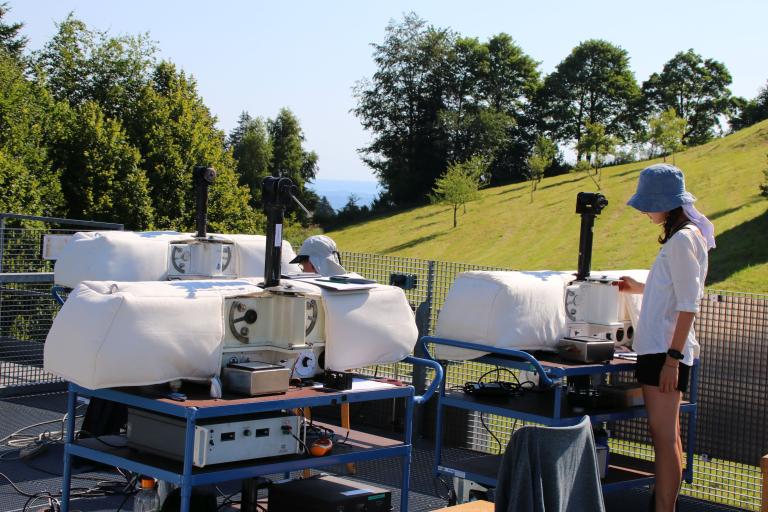
2022 planned activities of the Regional Brewer Calibration Center for Europe (RBCC-E)
The XVII Intercomparison Campaign of the Regional Brewer Calibration Center-Europe, will be held at Physikalisch-Meteorologisches Observatorium (Davos, Switzerland), from 22 to 31 August 2022. Physikalisch Meteorologisches Observatorium Davos, World Radiation Center (PMOD/WRC) Davos will host the event. This type of campaigns are organized every year (alternating between PMOD/WRC, Davos, Switzerland and INTA, El Arenosillo, Spain). For more information follow the link. Registration form is available at the RBCC-E web page . Please register before 31st March 2022.
European Calibration center will be assisting with the installation and start of observations of Brewer #84 at Atacama Desert, Chile in February 2022.
Brewer# 201 from Tamanrasset, Algeria was inspected, repaired in Izana and returned to Tamanrasset in January 2022. Brewer operator has been invited for training to Izana in 2022.
The XVI Regional Brewer Calibration Center for Europe (RBCC-E) intercomparison was held at El Arenosillo Atmospheric Sounding Station of the “Instituto Nacional de Técnica Aeroespacial” (INTA) during the period 6 – 16 of September 2021.
This campaigns are organized in collaboration with the “Atmospheric Research and Instrumentation Branch” of INTA, with the support of the Global Atmosphe Watch (GAW) program of the World Meteorological Organization (WMO).
In November 2003, and within the GAW/WMO program, the Regional Brewer Calibration Centre for RA-VI Region (Europe) (RBCC-E) was established by Izaña Atmospheric Research Centre (IARC) at Izaña Observatory (IZO, Canary Islands), managed by the “Agencia Estatal de Meteorología” (AEMET, Spain). Technical and organization information of the RBCC-E can be obtained at http://rbcce.aemet.es. At present the RBCC-E maintains a triad of reference instruments. The Regional Primary and Secondary Reference Spectrophotometers (Brewer #157 and Brewer #183), and the Regional Traveling Reference Spectrophotometer (Brewer #185) are part of the triad. Each spectrophotometer will be calibrated independently with the standard Langley method at IZO and since 2011 transfer their own calibration. Special conditions and restrictions apply in relation to COVID-19 pandemic situation.
More information on activities and available support is available at the RBCC-E web page
2021 - 2022 UV planned activities
From 13 June to 26 August 2022, the World Calibration Center for UV will organize the third International UV Filter Radiometer Comparison (UVC-III) at PMOD/WRC UV, Davos, Switzerland.
Quality Assurance of Spectral Ultraviolet Measurements (QASUME) site visits will take place as scheduled (on-demand by site operators).
2021 audit information:
- 15th RBCC-E, Arenosillo, Spain
- AEMET, Madrid, Spain
- ARPA, Aosta, Italy
The next International Radiation Symposium (IRS) will be held from 4-8 July, 2022 in Thessaloniki, Greece. For more information follow the link.
2019 XIV Regional intercomparison of the Brewer Calibration Center for Europe (RBCC-E)
XIV Regional intercomparison of the Brewer Calibration Center for Europe (RBCC-E) was held at El Arenosillo Atmospheric Sounding Station of the “Instituto Nacional de Técnica Aeroespacial” (INTA) during the period 17 – 28 of June 2019. The campaign was organized in collaboration with the “Area of Instrumentation and Atmospheric Research” of INTA, with the support of the Global Atmosphere Watch (GAW) program of the World Meteorological Organization (WMO) through Canadian Brewer Trust Fund. The Brewer travelling instrument from the Regional Brewer Calibration Center - Europe served as ozone reference and the Quality Assurance of Spectral Ultraviolet Measurements (QASUME) International portable reference spectroradiometer from Physikalisch Meteorologisches Observatorium Davos, World Radiation Center (PMOD/WRC) provided the UV calibration for the participating instruments. 21 Brewer spectrometers, 15 operators and experts from 11 countries took part in XIV Regional intercomparison campaign.
The main goal of the campaign was to transfer calibration from the reference standard to all participating instruments and to compare the instruments which are also reference standards for individual networks or are used as travelling standards. Environment and Climate Change Canada, International Ozone Services Inc. (OS), Kipp and Zonnen Inc., and Japan Meteorological Agency took part in this campaign.
The results of the blind comparison (using the instruments’ original calibration constants) were in agreement with previous campaigns, 6 instruments showed an agreement better than 0.5%, which represent 31% of the participating instruments. Of the remaining instruments, 74% showed an agreement inside the 1% range. After the maintenance tasks, performed by International Ozone Services Inc. (IOS), and using the new determined calibration constant and the stray light correction applied to single monochromator Brewers, the agreement of the all participating instruments with respect to the reference was very good: +/- 0.5%.
Detailed report (GAW Report No. 257) from the campaign is available in WMO library.

XIV Brewer Regional intercomparison campaign was open to all type of instruments measuring total ozone column. It also provided an opportunity to compare different measuring techniques to the Brewer Regional Standard. Dobson, ozonesonde, SAOZ, Pandora, Phaeton, FTIR (EM27), Qasume, Avodor, Max Doas, BTS, Nilu, AOTF instruments took part in the intercomparission of standard and alternative methods to measure ozone column. Results from their comparison are available at the RBCC -E web page and their analysis will be included in detailed report which is in preparation.

Dobson intercomparison campaign for Southern Africa, Irene, South Africa, 7 - 18 October 2019
The Dobson Intercomparison Campaign for Southern Africa was held in South Africa between 7th and 18th of October 2019. The campaign was hosted by South Africa Weather Service (SAWS) at the weather station in Irene. Eight Dobson Instruments from six countries: South Africa, Kenya, Botswana, India, Germany and USA participated in the campaign. A Dobson instrument from Nigeria was not able to participate due to delayed visa for the operator resulting in eight out of nine planned Dobson instruments to actually participate. This number of participating instruments amounts to almost 10 percent of the world’s operating Dobson spectrophotometers. The World Secondary Standard Dobson (USA) and the European Dobson (Germany) Standards were inter- compared after more than three years. The experts used the Word Secondary Standard Dobson (D065) and the European Standards (Germany) to intercompare the performance of the other instruments. All Dobson spectrophotometers from different monitoring and research institutions in Southern Africa and India were inspected, serviced as necessary and calibrated. The Dobson instrument from India needed extensive work and its mirrors were renewed. The three South African, and Kenyan Dobson spectrophotometers were serviced, inter-compared, calibrated and were in very good shape at the end of the campaign. The instrument from Botswana was cleaned and serviced and brought in a good condition. All participants were given as much as possible training and with renewed and regular email contact with SAWS and between the members the observations are expected to be of good quality.
Under strong commitment of maintaining regular contact, the operators from Botswana can be guided to resume the measurements at Maun. Through this activity, the data obtained at the measurement sites will be standardized, and will be comparable locally and globally. This event is part of WMO/GAW quality control requirements for monitoring atmospheric total ozone. The reports of individual instruments from this activity were prepared and shared with the community.
Detail report (GAW Report 253) is available in WMO electronic library.
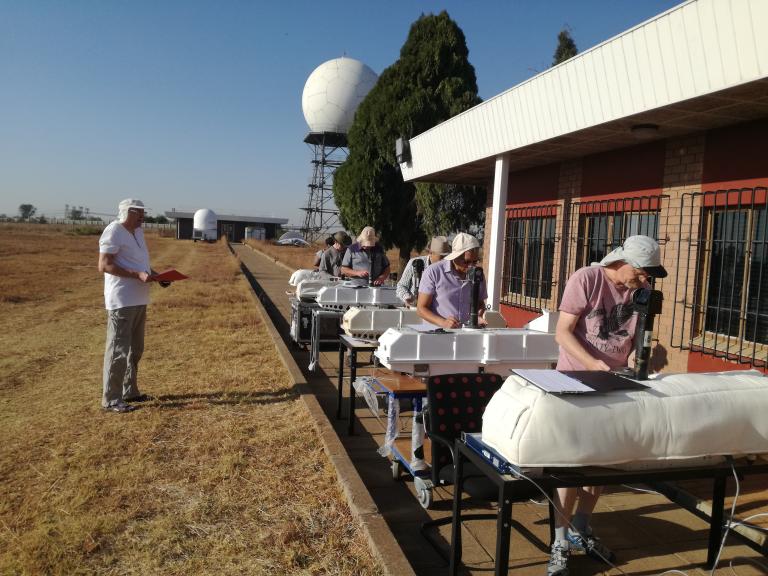
Dobson intercomparison campaign for Latin America and the Caribbean, Buenos Aires, Argentina, 4 – 22 March 2019
The international Comparison campaign of Dobson of Spectrophotometers (IC/BUA-19) of the WMO/GAW Region III took place in Villa Ortuzar Observatory, Argentina between 4 –22 March 2019. The intercomparison was organized by the WMO Secretariat, the Argentina’s National Meteorological Service (SMN), the USA National Oceanic and Atmospheric Administration’s Global Monitoring Division (NOAA GMD), and the University of Colorado’s Cooperative Institute for Environmental Research (CIRES). Participants included instruments and operators from: Argentina, Brazil (Dobson #093 from Natal and Dobson #114 from Cachoeira Paulista – São Paulo (both supported by the Brazilian Space Agency), Cuba, Mexico, Peru, Uruguay and NOAA’s traveling standard instrument. The primary purpose of the event was to check and harmonize calibrations and perform maintenance of Dobson spectrophotometers operated within region III of the WMO, as well as two instruments from region IV which also took part in the intercomparison campaign. Overall, twelve Dobson instruments participated in the intercomparison campaign: D065 (the World Secondary Standard instrument), D067, D070, D087, D093, D097, D098, D099, D114, D131, D133, D134. All eleven Dobson Spectrophotometers from six different monitoring and research institutions in Latin America were inspected, serviced and calibrated, as necessary, so that the data obtained at the measurement sites will be standardized, and be comparable locally and globally. The Regional Dobson Standard for South America was calibrated against the Word Secondary Standard stationed in Boulder, Colorado, USA. Instructions on the operation and routine maintenance of the instruments were provided to participants along with the final intercomparison to ensure that calibrations and repairs are correct and sufficient to bring instruments within an error of one percent. The relative uncertainty of each Dobson was also estimated. This event is part of WMO/GAW quality control requirements for monitoring atmospheric total ozone and assures the quality of total ozone data sets. In addition to the instruments participating in the Dobson intercomparison, the regional Brewer ozone spectrophotometer, and Pandora spectrometers owned by NASA conducted measurements at Villa Ortúzar during this period. Special Umkehr observations on the zenith sky were made by all participating instruments in the morning of 21 March 2019 to create a reliable data set for verification of different technologies used for processing these observations.
Detailed report (GAW Report 267) with results from the campaign is available in WMO electronic library.
2017 XII Regional intercomparison of the Brewer Calibration Center for Europe (RBCC-E)
XII Regional intercomparison of the Brewer Calibration Center for Europe (RBCC-E) was held at El Arenosillo Atmospheric Sounding Station of the “Instituto Nacional de Técnica Aeroespacial” (INTA) during the period 29 May - 9 June 2017. 20 Brewer spectrometers, 15 operators and experts from 9 countries took part in XII Regional intercomparison campaign. This campaign is part of the EUBREWNET ES1207 COST Action and is organized in collaboration with the “Area of Instrumentation and Atmospheric Research Area” of INTA, with the support of the Global Atmosphere Watch (GAW) program of the World Meteorological Organization (WMO). This activity will be used as demonstration campaign of the calibration methodologies and error assessment developed by the EMRP ATMOZ project (Traceability of Atmospheric Total Ozone).The action focuses on the calibration of Brewer spectrophotometers from Europe and North Africa. The RBCC-E provided ozone and Aerosol Optical Depth (AOD) calibration against the RBCC-E reference, whereas the Quality Assurance of Spectral Ultraviolet Measurements (QASUME) International portable reference spectroradiometer of the Physikalisch-Meteorologisches Observatorium Davos / World Radiation Center (PMOD /WRC) provided a global UV reference spectrum for the ultraviolet measurements.
The initial Brewer comparison results (using the instruments’ original calibration constants) indicated that the overall agreement is slightly lower than in the previous campaign; during this campaign 44% of the instruments presented an ozone deviation lower than 1% with respect to the reference. On this campaign 72% of the instruments agreed on the 2% range whereas in previous campaigns around 75% of the instruments reached this agreement. After the maintenance tasks, performed by International Ozone Services Inc. (IOS), using the new determined calibration constant and the stray light correction applied to single monochromator Brewers, the agreement with respect to the reference was very good:+/- 0.5%.
Detailed report (GAW Report 248) from the campaign is available at WMO library.

2017 Dobson intercomparison campaign for Australia and Oceania, hosted by the Australian Bureau of Meteorology
The WMO Global Atmosphere Watch regional Dobson intercomparison campaign was held at the Bureau of Meteorology field annex outside Melbourne, Australia, 13– 24 February 2017. The campaign was designed primarily for the intercomparison of the regional association V (South-West Pacific) Regional Standard Dobson (D 105) against the World Standard (D 083). Two additional Dobson instruments from the region’s member countries also participated - D 072 from Lauder, New Zealand, operated by the National Institute of Water and Atmospheric Research and D 052 from Manila, operated by the Philippines Atmospheric, Geophysical and Astronomical Services Administration. Furthermore, the regional association II (Asia) Standard (D 116), operated by the Japanese Meteorological Agency, also took part in the intercomparison in order to provide traceability of Asian instruments to the World Standard. All the participating instruments were successfully calibrated against the World Standard during a short spell of sunny weather in the second week of the campaign. The General Trust Fund for Financing Activities on Research and Systematic Observations Relevant to the Vienna Convention supported the travel costs of the two participants from the Philippines as well as the shipping of Dobson 052 from Manila to Melbourne, Australia. This support also enabled the extensive training provided by Dobson experts from Australia, Japan and the United States regarding Dobson operation and testing procedures, as well as the refurbishment and repair of the instruments. Together, these actions should ensure a high quality of ozone observations in the tropical western Pacific.

Jülich Ozone Sonde Intercomparison Experiment 2017 Jülich, Germany, 9–20 October and 23 October–3 November 2017
In October/November 2017, the joint JOSIE (Juelich Ozone Sonde Intercomparison Experiment) - SHADOZ campaign (Smit and Thompson, 2017) was conducted at the World Calibration Centre for Ozone Sondes (WCCOS: https://www.fz-juelich.de/iek/iek-8/EN/Expertise/Infrastructure/WCCOS/WCCOS_node.html), established at the Research Centre Juelich, Germany. The main objective was to resolve on-going discontinuities in the existing ozonesonde data records in general and particularly in SHADOZ due to ground equipment, Standard Operating Procedures (SOP’s), and changes in sonde manufacture and performance (See videos: https://www.youtube.com/watch?v=5KwHw4gNLzg & https://www.youtube.com/watch?v=zOgL_0_pu00). A unique feature of JOSIE–SHADOZ was that the ozonesondes were prepared by 12 operators from organizations representing SHADOZ sites in 9 countries including Brazil, Costa Rica, France, Germany, Kenya, Malaysia, South Africa, Vietnam and USA (see video: https://vimeo.com/240986625). The JOSIE 2017-SHADOZ results have been presented at several scientific workshops and conferences (e.g. EGU, AGU, SPARC, CIMO-TECO etc.) and published in scientific literature (Thompson and Smit et al., 2019). The new insights gained in result of this Intercomparison Experiment have brought the community forward in making important steps to improve the performance of the ozonesondes, in scientific as well as operational perspective. Those results also lead to initiating a new WMO-NDACC-IOC activity: Assessment of Standard Operating Procedures (SOPs) of Ozone Sondes (ASOPOS 2.0) to evaluate and revise the existing Standard Operating Procedures to improve the uncertainty level of ozonesondes to less than 5-10 % in the global ozonesonde network of WMO/GAW-NDACC-SHADOZ.
Physikalisch Meteorologisches Observatorium Davos, World Radiation Center (PMOD/WRC) Davos past intercomparison activities
The 2nd International solar UV filter radiometer comparison and calibration campaign (UVC-II) took place at the World Calibration Center -UV, Davos, Switzerland from 25 May to 5 October 2017. 57 Participants from 36 countries with a total of 75 instruments took part in the campaign. The results from this intercomparison and calibration campaign were published in GAW Report 240.
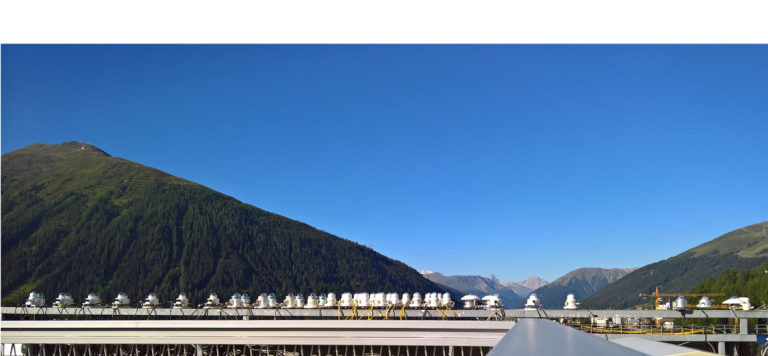
In the period 2017-2020, the World Calibration Center-UV (WCC-UV) organized 8 site audits and participated to 2 ozone and UV campaigns organized by the Regional Brewer Calibration Center for Europe (RBCC-E) at El Arenosillo Atmospheric Sounding Station of the “Instituto Nacional de Técnica Aeroespacial” (INTA), Spain. The UV calibrations were referenced to the portable reference spectroradiometer Quality Assurance of Spectral Ultraviolet Measurements (QASUME). These events led to 25 calibration certificates with formal traceability to SI via the WCC-UV. The site audit reports are available on the QASUME web-site.
Large number of solar UV filter radiometers are calibrated at the World Calibration Center-UV (WCC-UV) at Davos, Switzerland trough intercomparisons, audits and services. Every year the Brewer #185 of the Regional Brewer Calibration Center for Europe (RBCC-E) is compared with the Quality Assurance of Spectral Ultraviolet Measurements (QASUME) International portable reference spectroradiometer from Physikalisch Meteorologisches Observatorium Davos, World Radiation Center (PMOD/WRC). QASUME is a travel reference UV spectroradiometer which allows inter-comparison campaigns of global solar irradiance measurements from different instruments (array spectroradiometer, scanning spectroradiometer) to be conducted at the user’s site rather than at PMOD/WRC. The solar UV filter radiometer calibration at the WCC-UV consists of the spectral and angular responsivity measured in the optical laboratory, followed by the instrument responsivity from the solar comparison to the reference spectroradiometer QASUME on the measurement platform of PMOD/WRC. These calibrations are performed during the summer months from May to October, when the solar elevation exceeds 40°.

Equipping Issyk-Kul station, Kyrgyzstan with Brewer spectrophotometer to monitor the ozone layer over the mountainous region of Central Asia
Refurbished MKIV Brewer # 083 was donated to WMO by Environment and Climate Change Canada and it has been loaned to the Institute of Innovative Professions, Kyrgyzstan. The objective of this loan is to equip the mountainous region of Central Asia and in particular Issyk-Kul station, Kyrgyzstan with instrument to monitor the state of the ozone layer and the UV levels at high temporal resolution and precision. The reliability, efficiency and continuity of the total ozone monitoring in the atmosphere at that location is important for forecasting the state of the ozone layer and climate change, and for addressing regional environmental and economic problems associated with changes in the ozone layer and climate. The relevance is confirmed by the fact, that the final documents of the 10th ORM meetings (28-30 March 2017, Geneva; November 20-24, 2017, Montreal) included a proposal on the importance of renewing, and in some cases, the expansion of the system of regular long-term monitoring of total ozone in the mountain regions of Central Asia and the Himalayas. Total ozone observations will complement the suite of measurements already contributing to WMO-GAW Programme on aerosol, reactive gases and GHG. Measurement data series obtained on the base of Issyk-Kul station have unique duration (over 35 years) and their complexity and complementary character will allow investigating the patterns of changes in ozone and greenhouse gases. During the existing period of observation (1980 - 2016), an ozone depletion took place prior to 2002 by an average of 8 %, and in the last decade, its recovery was observed over Central Asia. During the same period, the accumulation of CO2 and greenhouse effect occurred. For mountain conditions, the effect of solar and geophysical processes on the variability of the studied impurities was more significant than that of the ocean and the plains. Its long-term experimental data are used to develop and verify the models for forecasting of the ozone layer changes, greenhouse gases content and climate in the central part of the Eurasian continent.
While the implementation of the project has been delayed by COVID-19 pandemic, significant progress had been achieved in the summer of 2021. The institute constructed an observation platform and a storage room. The site power and communications had been upgraded. Using online instructions the site operators had been trained and were able to install the Brewer at Issyk-Kul Ozone Monitoring Development (OMD) station. Observations had commenced in the fall of 2021 and continued to be supported remotely by experts.
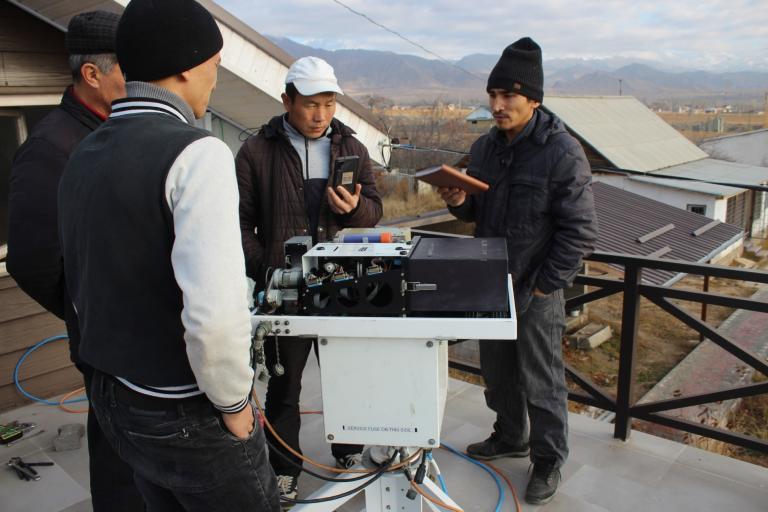
Project to establish total ozone observing station in the Union of the Comoros
The “Project on the establishment of an ozone observatory in Comoros” was initiated in April 2021. The objective of the project is develop capacity of Comoros in terms of monitoring and research of the atmosphere and climate. More specifically it aims to commence total column ozone observations in Comoros in relation to the Montreal Protocol and its Vienna Convention and to undertake research of its variability and long -term trend. A new miniSAOZ instrument are to be acquired and installed at a station in the Union of the Comoros. Those observations will contribute to monitoring and scientific activities of the Global Atmosphere Watch Programme of WMO and to the scientific assessments of the state of the ozone layer. The data from Comoros have big regional representativeness and they will fill in a gap in global observations. They are expected to contribute to better understand the processes that impact ozone close to the surface and its global circulation in higher altitudes, and also to determine the impact of different factors on the distribution and variability of ozone.
The Ecuadorian Highlands Ozone Sondes (ECHOZ) project
One year of launches of ozone sondes at recently built high-altitude atmospheric measurement station at Universidad San Francisco de Quito in Ecuador (USFQ) were supported by the Vienna Convention Trust Fund for the period from 1 March 2020 to 30 June 2021. This project aimed to expand monitoring capabilities to regions where observations of atmospheric constituents are scarce and to provide the ozone scientific community with an unique set of data to monitor stratospheric ozone over the equatorial Andes. Those observations would be supported by the Government of Ecuador in subsequent years. Ozonesondes flights were planed with a frequency of two soundings per month for the duration of this project. Ozone soundings at USFQ’s Atmospheric Measurement Station (EMA, Spanish acronym) were initiated at the beginning of March 2020. EMA’s coordinates are -0.1964, -78.435, and 2414 masl (meters above sea level).
The first ozone sonde launch under the ECHOZ project was executed on 6 March 2020 in the presence of Government officials and university authorities. Subsequently, the launches were put on hold between 16 March 2020 and the end of May 2020 due to the COVID-19 pandemic lockdown. They were resumed at the end of May 2020 and regularly carried out at frequency twice a month until June 2020. 25 sondes have been launched and data have been collected following strict protocols to ensure that the data set is of high quality. A major limitation caused by the pandemic was to operate with reduced personnel for launches and for data processing. Five additional sondes were launched between July and August 2021. Due to the lack of personnel and pandemic difficulties, data processing has been delayed. USFQ team is working on data processing for a publication that will compare the entire time series with the satellite data. Collected data will be archived at https://observaciones-iia.usfq.edu.ec , where previous (2014-2019) time series are already available. In order to ensure the continuity of ECHOZ soundings, a collaboration between USFQ and the NASA SHADOZ (Southern Hemisphere Additional Ozonesondes) network has been established. Furthermore, through this collaboration supplies for four additional years from Quito station will be provided and USFQ team will begin launching ozonesondes from their Galapagos campus starting in 2021. This project has been instrumental for expanding and consolidating ozone observations in Ecuador not only in the stratosphere over the Andes, but also in the troposphere, where it is relevant to the human health. The equipment and ozone observation capacity had been augmented at USFQ which will contribute the ozone observations in the region serving multiple needs. The results had showed substantial changes in ozone photochemistry near the surface during the onset of the COVID-19 pandemic. These observations were published in 2020 article and more papers have been in preparation.

18th WMO-GAW Brewer Workshop
The event was held online as series of three sessions, each addressing a particular theme from 14 June to 21 June 2021. 119 participants registered for this event. Each one of the sessions was attended by 65 - 97 participants.
The Programme included:
Session 1. (Mon 14th June 2021, 15:00-17:00 UTC) The objective of the session was to maintain the community well informed and to discuss its needs and plans. Selected experts were invited to present to the community recent scientific and technical advancements related to Brewer operation, calibration, data processing and data management. In addition to those WOUDC and WMO-GAW provided an update on advances, changes and plans. 20 minutes discussion followed up the presentations.
Session 2. (Thu 17th June 2021, 15:00-17:00 UTC) The objective of this session was for the community to build understanding of the progress, advancements, challenges, and needs of individual stations/users/networks. The operators, station managers, PI, researchers and data managers have been encouraged to submit short presentations on all topics relating to their work involving Brewer Spectrophotometers, ozone or UV measurements, calibrations, data processing, etc. Their input is very important for the good planning of our work. The session included 20 minutes discussion.
Session 3. (Mon 21st June 2021, 15:00-17:00 UTC) The objective of this final session was to provide advice and answer practical questions to the community, particularly for new operators, in aspects of Brewer operation, characterization, calibration and data submission in so far as this can be achieved through online presentation and discussion. In this respect, participants were strongly encouraged to submit suggestions on topics to cover, problems, or any issues which participants considered as important to improve their capacity to provide high quality data. Experts delivered tutorials on Brewer Measurement Practices, Brewer Calibrations, Brewer UV measurements and determination of Aerosol Optical Depth in EUBREWNET in the area of capacity development. 45 minutes discussion included identifying causes for anomalous UV observations, gaps in observations, need of updated SOPs, calibrations guiding documents, future observing needs and the future of GAW observing network, capacity development needs and plans.
2022 Initiating Brewer ozone and UV observations at station Chajnantor Plateau, Chile
Environment and Climate Change Canada donated two Brewer spectrophotometers to WMO in 2019. WMO-GAW and the Advisory Group of the Vienna Convention Trust Fund received a number of project proposals from different countries to integrate donated instruments within the global ozone and UV monitoring networks. Following a review process, one of the two spectrometers was transported to Chile and Research Platform of the University of Santiago on the Chajnantor Plateau was prepared to accommodate the new instrument. However, the COVID pandemic interfered with the completion of this project and decision was made to commence measurements from a temporary site. The Brewer spectrophotometer at both its current location (2600 m asl) and its intended location (5100 m asl in Atacama), contribute to collecting data on the total ozone column at high-elevation sites. The instrument is already filling a gap in the Ozone Monitoring Network in the southern Andes. After moving it to the Atacama Desert, the instrument will become an excellent complement for the ozone measurements being carried out at Bolivian sites. Ground-based measurements of both ozone column and UV radiation are extremely import at sites that are simultaneously low-latitude and high-elevation, where the world’s highest levels of surface UV have been measured. It is expected that the Brewer#84 will make the platform at station Chajnantor Plateau, Chile in Atacama Desert the highest Brewer site in the world.
The relocation of Brewer#84 to station Chajnantor Plateau was carried out in February 2022 with on-site assistance of Alberto Redondas from Regional Brewer Calibration Center – Europe at AEMET- Meteorological State Agency, Spain.
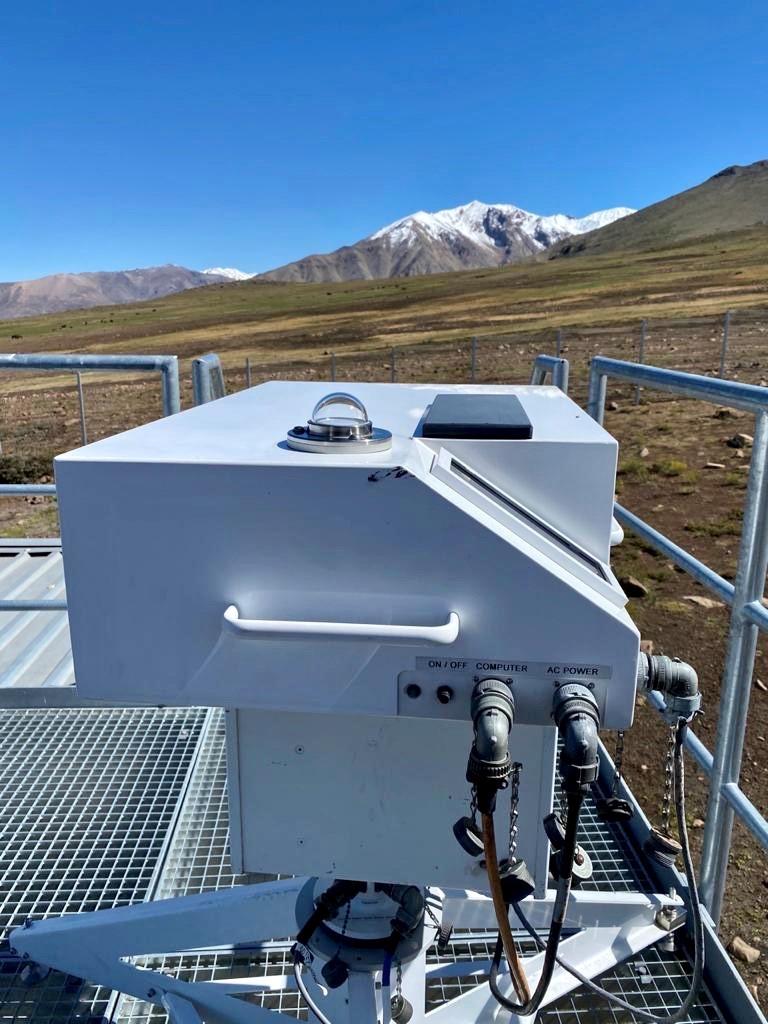
2021 WMO Regional Dobson Calibration Center for Europe activities, Hohenpeissenberg (MOHp), Germany
The highlight of the activities of the WMO Regional Dobson Calibration Center for Europe (RDCC-E) at the Meteorological Observatory Hohenpeissenberg (MOHp) in Germany was the shipment of the very old Dobson D008 from Spitsbergen to Hohenpeissenberg in 2021. The instrument had been in operation at the stations in Longyearbyen and Ny Alesund for many years since 1950. Regular observations were stopped in the early 2000 and the instrument has then been stored in the Svalbard Museum. The RDCC-E succeeded in negotiating availability of this instrument for observing purposes. It had been transported to MOHp workshop for complete refurbishment. It will be upgraded and included in the WMO calibrations in the summer of 2021, which will make it ready for relocation and future deployments. Meanwhile, this instrument will be used for training and education (repair, exchange of parts and optical alignment) of Dr. Voltaire Velazco as successor of the current scientific head of the RDCC-E Ulf Köhler.
2019 Inspection of Indian Brewer network instruments
India Meteorological Department (IMD) has five Brewer Spectrophotometers (MKIV No. 89, 94, 153, 164 and 170), which are not operational at present. IMD organized a review meeting in India in November, 2019 for inspection of these instrument and Mr. Alberto Redondas attended the meeting as WMO representative under the request of IMD. Mr. Redondas is a Senior Scientist and ozone and spectral UV group manager at the Izaña Atmospheric Research Centre, Spain and scientific manager of the Regional Brewer Calibration Center - Europe. Status report was prepared. It had been presented to WMO and it had been used for planning future capacity development activities of WMO-GAW Scientific Advisory Group on O3 and UV. When returned to operational mode, these instruments will be installed in different cities in India namely New Delhi, Kodaikanal, Pune, Leh and if required, one may be sent to Indian permanent station in Antarctica. IMD has continuous observations of Total Columnar Ozone across the country since 1957.
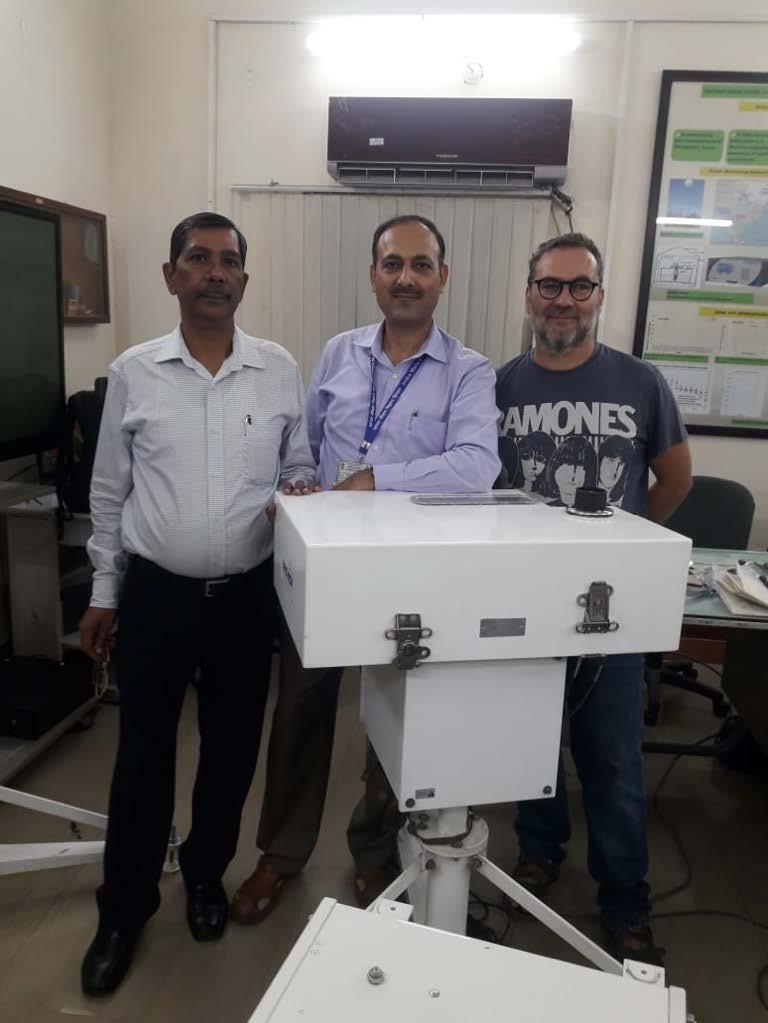
Collaborative effort between Kenya, Canada and Switzerland resulted in successful deployment of Brewer #071 at Nairobi station and initiated Brewer total ozone column observations
Environment and Climate Change Canada donated refurbished Brewer #71 to the World Meteorological Organization. The instrument has been loaned to the Kenyan Meteorological Department. A team of MeteoSwiss helped with the installation of Brewer # 071 at Nairobi station in Kenya in December 2019. The instrument is been set to operate continuously in an automated mode and is equipped with semi- automated Quality Assurance and Quality Control.Collected total ozone column data are available from the EUBREWNET website and are complemented by regular radiosonde Ozone profiling from that station. Experts from MeteoSwiss provided training on operation and maintenance to staff of Kenyan Meteoritical Department. The support and training by MeteoSwiss is continuing.
17th WMO - GAW Brewer Operator course, Spain 2019
Brewer experts and operators were invited to take part in the 17th Brewer operator course which was hosted by the Spanish Meteorological Agency (AEMET), from the 17th to the 21th of June 2019. Travel support to participants was provided trough WMO and the Canadian Brewer Trust Fund. 25 Brewer operators received training tailored for participants with wide range of experience. 5 trainers tutored operators divided in 4 groups. The training programme included short introduction to the scientific foundations of the measurement methods for UV, NO2, SO2, AOD, column ozone and ozone profiles and practical training on operational and technical issues of the Brewer spectrophotometer. The hands-on training covered the topics of Brewer instrument set up, basic operation, maintenance, service, calibration and quality control. Set up and use of software for data acquisition, processing and evaluation of ozone, UV and profiles and preparation of data for submission to WOUDC were in the focus of half of the training programme. As with previous Brewer workshops, all participants were strongly encouraged to bring their Brewer observations and history and submit oral or poster presentations about their work.
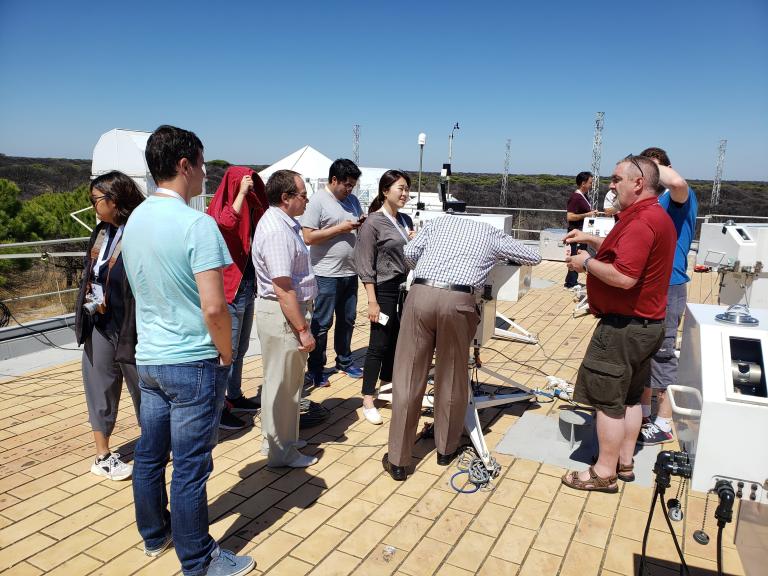
2018-2019 Capacity-building on data management and instrument calibration in Kenya
A special WMO-UNEP capacity-building initiative was designed for WMO region I in 2018-2019. It was implemented as part of a continuous process to strengthen or develop technical and scientific capacity. Substantial expertise is required to maintain high quality measurements, data processing and analysis and relevant knowledge on preparation and submission of observation data to relevant world data centers. The United Nations Environment Programme through the General Trust Fund for Financing Activities on Research and Systematic Observations Relevant to the Vienna Convention and the World Meteorological Organization jointly provided financial support. The Federal Office of Meteorology and Climatology the Swiss Federal Laboratories for Materials Science and Technology (Empa) and the Czech Hydrometeorological Institute jointly implemented the activity in 2 phases, addressing staff of the Kenya Meteorological Department (KMD). The first part of the training focused on data management and instrument calibration and took place in Hradec Kralove, Czech Republic and in Payerne, Dübendorf and Zürich, Switzerland, from 17th June to 6th July 2018. Four KMD staff participated in full day sessions that included lectures, practical exercises and hands-on training. KMD staff shared and expanded their theoretical and practical knowledge on the Dobson and Brewer spectrophotometer measurement techniques, service, maintenance, and calibration of the instruments and the data archiving and analysis. The group also engaged in intensive training and knowledge on ozone sondes including their preflight preparation, Standard Operations Procedures (SOPs) for launching, data acquisition, processing, analysis, and transmission and archiving. Further, operation, quality management, and traceability of in-situ surface ozone and greenhouse gas observations was addressed. The Observation System Capability Analysis and Review tool OSCAR/Surface platform of WMO was introduced along with practical work on improving the metadata information on Kenyan GAW contributions. A separate session was dedicated to introducing the R data analysis environment to help systematically analyze both the vertical ozone profile and surface data. Continued training, instructions and support of KMD personnel by advanced centers in chemical measurements are key to success and sustainability of GAW operations in Kenya and the region. The knowledge and skills gained in the training lead to improved work performance at KMD and were shared with colleagues and students at the WMO Regional Training Center, Institute of Meteorological Training and Research IMTR, Nairobi, Kenya.

The competencies of 8 KMD operators and engineers were further advanced through a workshop on data management and instrument operation that was held between 17th and 29th March 2019 at KMD Headquarters in Nairobi as well as at the Global GAW station Mount Kenya. The objective of this second phase of the training was to reinforce and enhance already acquired knowledge and skills in the operation of ozone measuring instruments and data handling. To this end, the group reviewed best practices in conducting measurements, instrument calibration, management of data, documentation of the data using metadata and submission of data to the World Data Centre on Ozone and UV (WOUDC). Specific sessions addressed working with OSCAR/Surface and WIGOS metadata related to the observations made from Kenyan GAW stations; operating, maintenance, and troubleshooting of ozone sondes and Brewer spectrophotometers; retrieving vertical profiles from ozone sonde flights and analyzing data. Trainers and trainees alike greatly appreciated the opportunity to work together for the benefit of improving the quality of the observations made by KMD and to ensure the sustainability of the regional and global monitoring activities. At the end of the workshop, participants discussed means to maintain and transfer the skills beyond the initially trained staff whenever appropriate.

GAWTEC training course on UV
The 34th GAWTEC training course was held at Schneefernerhaus on Zugspitze, Germany from 13 May to 26 May 2018 on solar UV radiation and data quality assurance and control. Please find more information here.
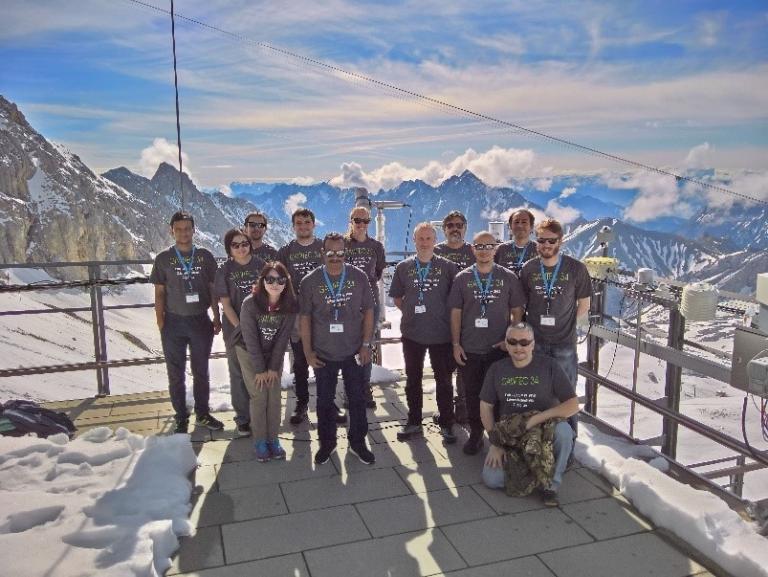
Brewer Operators' Course for Asia and Pacific region, Sydney, Australia 2017
Brewer training course dedicated to the needs of Brewer operators in Asia and Pacific Region took place in Sydney, Australia from 4 to 8 September 2017. It was hosted by the Bureau of Meteorology in its Sydney office. Four international Brewer experts in addition to those from Australia and Japan provided state-of-the-art training to 15 Brewer operators from China, India, Indonesia, Japan, Korea, Malaysia, Thailand, Korea and Vietnam as well as Australia. Detailed hands-on instruction was provided to participants in topics such as the set-up and operation of Brewers, basic maintenance, lamp-tests, software installation, establishing measurement schedules and data processing and submission. The workshop is expected to greatly improve the skills and knowledge of Brewer operators in south and east Asia, to ensure instruments are being operated according to the best modern practice and thereby will result in increased submission of high quality total ozone data. Travel support for participants from developing countries was provided by WMO trough the Canadian Brewer Trust Fund.
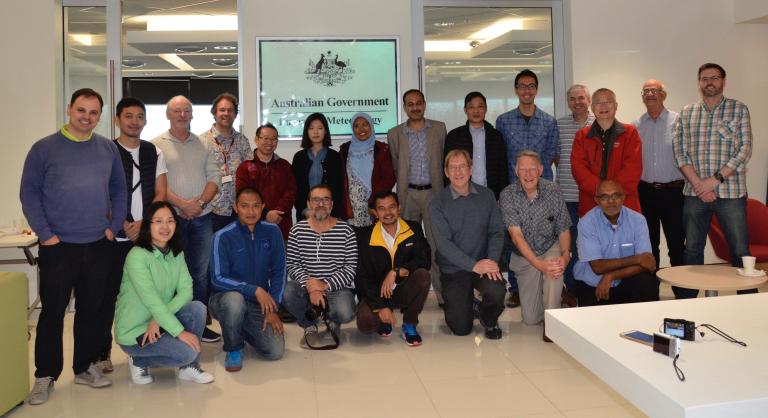
Jülich Ozone Sonde operators training Jülich, Germany, 9–20 October and 23 October–3 November 2017
The ozone sonde operators’ training organized as part of Juelich Ozone Sonde Intercomparison Experiment (JOSIE) aimed to fulfil a need to examineozone sonde operations as they have been performed at different stations. Those capacity-building activities during two JOSE sessions included lectures on sonde quality assurance, the importance of metadata reporting, troubleshooting, and hands-on training with coaches from sponsoring organizations: NASA GSFC, NOAA/GMD, KNMI (Netherlands), KMI (Belgium), MeteoSwiss, Environment and Climate Change Canada, and the Finnish Meteorological Institute (Thompson & Smit et al., also Presentation by Witte, 2018). Operators from SHADOZ (Southern Hemisphere ADditional OZonesondes) stations in Brazil, Costa Rica, Kenya, Malaysia, La Réunion (France), South Africa, Surinam and Vietnam participated in provided training activity. 6 coaches from Finland, Netherlands, and USA guided and advised operators on best practises and standardized approaches to ensure the high quality of measurements and data. 10 more experts from Belgium, Canada, Germany, Japan, Switzerland and USA took part in this Intercomparison Experiment as referees and observers. This activity allowed the exchange of new ideas, new techniques, and discussed the need of new adaptations to SOPs in the tropical environments. It built on the momentum gained through JOSE ozone sonde intercomparison to ensure continuation of the high-quality measurements. Operators are essential contributors to ozonesonde quality assurance by providing detailed metadata information on each sonde launch and maintaining uniformity in their preparation and launch procedures. Bringing together operators for training and knowledge sharing helps to ensure that best practices are applied to operations in a consistent manner across the ozone sonde network.
2017 Dobson operators' training for Australia and Oceania, hosted by the Australian Bureau of Meteorology
The WMO Global Atmosphere Watch regional Dobson center provided training to local operators as as part of organized regional Dobson intercomparison campaign held at the Bureau of Meteorology field annex outside Melbourne, Australia, 13– 24 February 2017. The event was primarily for the regional association V (South-West Pacific). Participants in this capacity building activity included operators from Australia, New Zealand, Philippines and Japan. The extensive training was provided by Dobson experts from Australia, Japan and the United States and included topics of Dobson operation and testing procedures, as well as the refurbishment and repair of the instruments. This activity is expected to ensure a high quality of Dobson ozone observations in the tropical western Pacific.
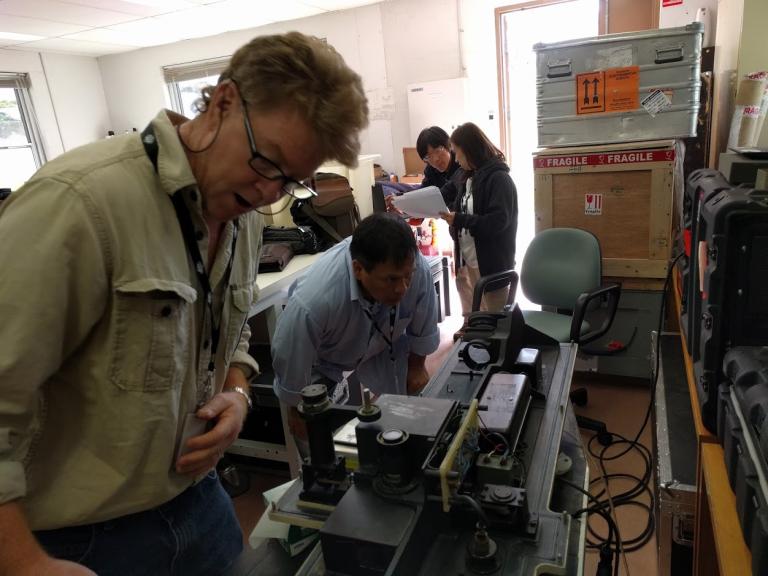
After opening of the Regional Dobson Calibration Center - Europe at DWD Met. Obs. Hohenpeißenberg on 28 June 1999 we celebrated 20 years Regional Dobson Calibration Center – Europe on 2 October 2019
On 19 September 2019, the Royal Meteorological Institute of Belgium hosted a scientific symposium celebrating the 50 years of ozonesonde measurements at Uccle station Belgium
Southern Hemisphere ADditional OZonesondes (SHADOZ) project celebrated 20 years in 2019.
When the SHADOZ network was proposed by NASA’s Goddard Space Flight Center and NOAA's Global Monitoring Division in 1997, regular soundings at latitudes between 25° N and 25° S were nearly nonexistent. There were 14 stations with at least 10 years of operation at the time of the celebration.
After one or two years of testing, regular balloon-soundings with Brewer-Mast ozone sondes started at Hohenpeissenberg, Germany on November 2nd, 1966 and we celebrated 50 years ozone measurements at Hohenpeißenberg, Germany on 22 September 2017
The Quadrennial Ozone Symposium October 2021
Since the last QOS that took place in Edinburgh in 2016, a variety of new developments has taken place on all facets of atmospheric ozone, including its observation and impact on human health and ecosystems. The Symposium’s program addressed all these aspects. Key topics included: stratospheric and tropospheric ozone observations and modelling; interactions between ozone, atmospheric chemistry and climate; Ozone-depleting substances, sources, sinks, and budgets, ozone measurement techniques; and effects on human health, ecosystems, and agriculture. Engagement with stakeholders and policymakers was also a key feature.
11th Meeting of the Ozone Research Managers of the Parties to the Vienna Convention
In accordance with decision I/6 and III/8 adopted at the First and the Third Meetings of the Conference of the Parties to the Vienna Convention for the Protection of the Ozone Layer, the Eleventh Meeting of the Ozone Research Managers of the Parties to the Vienna Convention (11ORM) will be held on line from 19 to 23 July 2021. The objective of the 11ORM is to review ongoing national and international research and monitoring programmes to ensure the proper coordination of these programmes and to identify gaps that need to be addressed. An important output of the meeting was a set of recommendations to guide efforts of the Parties in terms of priority research areas, systematic observations, gaps in global coverage of atmospheric monitoring of controlled substances and options to enhance such monitoring, data archiving, data stewardship, and capacity building. The recommendations from the meeting were communicated to and considered by the Twelfth Meeting of the Conference of the Parties to the Vienna Convention (part II) which was held jointly on-line with the Thirty-Third Meeting of the Parties to the Montreal Protocol during the period 13 September 2021 – 4 October 2021. The presentations were followed by informal and briefing meetings 5-19 October 2021. The Annual Meeting of Advisory Group of Vienna Convention Trust Fund was held online on 12 July 2021.
The full Report from 11th ORM is published and available in WMO electronic library as GAW Report 271.
The agenda of the 11th ORM and meeting presentations are posted on the meeting portal: https://ozone.unep.org/meetings/11th-meeting-ozone-research-managers-part-ii .
International Radiation Symposium 2022
The next International Radiation Symposium (IRS), originally planned for July 2020 was postponed twice due to the COVID-19 Pandemic, will be now held from 4-8 July, 2022 in Thessaloniki, Greece. IRS2022 is organized by the International Radiation Commission (IRC), the International Association of Meteorology and Atmospheric Sciences (IAMAS) and the Laboratory of Atmospheric Physics of the Aristotle University of Thessaloniki (AUTh). IRS2022 will provide a comprehensive international forum for presenting and discussing recent research achievements and technological developments on atmospheric radiation and related disciplines. You are cordially invited to attend the symposium to present your scientific work and exchange ideas with top scientists in the Atmospheric Radiation community. IRS2022 will offer keynote presentations under the Topical Union Session, parallel paper presentations, and poster sessions.
The Symposium comprises the following sessions:
- Topical Union Session
- Radiative Transfer Theory and Modeling
- Particle Radiative Properties
- General Remote Sensing
- Ground-based Measurements and Field Observations
- Radiation Budget and Forcing
- Weather, Climate and Environment Applications
- Solar UV Radiation
- Ocean Optics
- Climate Change in the Mediterranean and Radiative Impacts of a Changing Environment
Submission of Abstracts will be open from 1 September through 15 December 2021. Please look for details at the symposium’s website: https://www.irs2022.org/preparation-of-abstracts/. Please note that all abstracts submitted to IRS2020 must be submitted again.
Registration will open starting on 1 September 2021 at: https://www.irs2022.org/register-now/.
On behalf of the Local Organizing Committee, Alkis Bais
Symposium Support: NB events- Conference Services 5, Adrianoupoleos str. 55133 Thessaloniki, Greece Tel: +30 2310 223461 email: info irs2022 [dot] org (info[at]irs2022[dot]org)
irs2022 [dot] org (info[at]irs2022[dot]org)
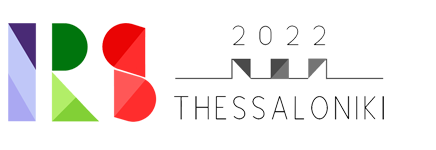
Dobson Operational Handbook and Dobson tutorial videos from the WMO Regional Dobson Calibration Center for Europe at the Meteorological Observatory Hohenpeissenberg (MOHp) in Germany:
The Dobson spectrophotometer, its function and technical parts are described in several basic papers (Dobson 1957a, 1957b, Dobson et al.1962, Komhyr 1980 etc.) - see Papers. This page contains instructional videos about operation of the Dobson spectrophotometer and also papers on specification of new components and upgrades developed by other specialists in recent years.
|
Inside NOAA Ozonesonde Lab: https://youtu.be/i2_m5ZHOafU
Inside NOAA Dobson Lab: https://youtu.be/byg3-zg58K4
Inside Juelich Ozone Sonde Lab:
Calibration ozonesondes: https://www.youtube.com/watch?v=5KwHw4gNLzg
